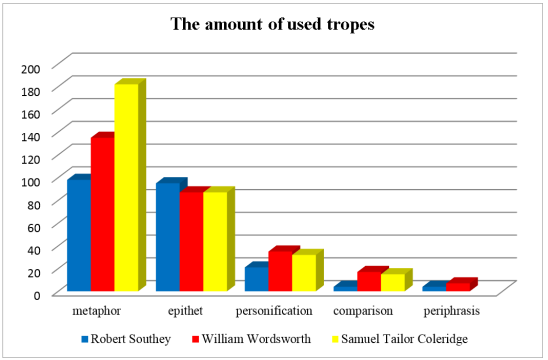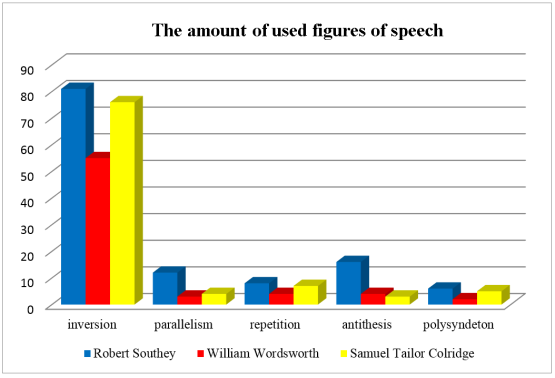A desire to improve quality of speech and to enhance it logically and emotionally led me to examination of techniques that serve for these purposes in the English language. Such techniques are called stylistic expressive means. In order to examine the role of stylistic expressive means of English I have conducted a research, the main purpose of which was to identify the most commonly used stylistic expressive means of the English language as well as to study their main features and peculiarities of usage. I find this study rather actual, as expressive means have widespread usage: from everyday speech to literature and political rhetoric.
Stylistic expressive means are techniques that serve to emotionally and logically enhance speech in English. Analysis and study of stylistic expressive means attracts attention today in connection with the need to identify areas in different languages, and it allows you to highlight similarities of life, culture, history, and the psychology of nations. Knowledge of stylistic expressive means of the English language helps to understand the mentality of the nation's language better. The most popular stylistic expressive means of English can be divided into two large groups: tropes and figures of speech.
The first and the most extensive group of stylistic expressive means of the English language is called tropes. When speakers or writers intend to express meanings of words differently from their literal meanings, they use trope. In other words, it is a metaphorical or figurative use of words in which writers shift from the literal meanings of words to their non-literal meanings. The trope, in fact, could be a phrase, a word, or an image used to create artistic effect. The tropes include: metaphor, metonymy, irony, epithet, oxymoron, comparison, hyperbole, understatement, periphrasis, personification, etc.
Figures of speech comprise another vast group of stylistic expressive means of the English language. The stylistic effect of figures of speech is based on the principle of unusual arrangement of linguistic units, unusual construction or extension of the utterance. Figures of speech are: inversion, parallelism, repetition, polysyndeton, antithesis, ellipsis, etc.
In spite of the fact that stylistic expressive means of the English language are generally studied, I didn’t find a lot of information about the most commonly used stylistic expressive means of English and they were not studied in lyrical works of the «Lake School» poets. So I have decided to analyze some lyrical works of Lakers and examine the role of stylistic expressive means of the English language. Aiming to make my analysis fair I have analyzed the same number of lines written by each poet. Genres of analyzed lyrical works fluctuate from sonnets to ballads. I have analyzed 30 poems written by representatives of the “Lake School” of English poetry: 21 sonnets, 3 ballads and 6 poems that consist of the same amount of lines. For example:
|
Speech figure | |
|
word — inversion |
word — ellipsis |
|
word — antithesis |
word — interjection |
|
word — parallelism | |
|
word — polysyndeton | |
|
word — repetition | |
“Daffodils”
I wandered lonely as a cloud
That floats on high o'er vales and hills,
When all at once I saw a crowd,
A host, of golden daffodils;
Beside the lake, beneath the trees,
Fluttering and dancing in the breeze .
Continuous as the stars that shine
And twinkle on the milky way,
They stretched in never-ending line
Along the margin of a bay:
Ten thousand saw I at a glance,
Tossing their heads in sprightly dance.
The waves beside them danced ; but they
Out-did the sparkling waves in glee:
A poet could not but be gay,
In such a jocund company:
I gazed --and gazed -- but little thought
What wealth the show to me had brought :
For oft, when on my couch I lie
In vacant or in pensive mood,
They flash upon that inward eye
Which is the bliss of solitude;
And then my heart with pleasure fills ,
And dances with the daffodils.
William Wordsworth
Tropes:
Epithets: “ golden daffodils”, “never-ending line”, “sprightly dance”, “sparkling waves”, “jocund company”, “pensive mood”, “inward eye” ; metaphors: “a crowd,a host, of golden daffodils”, “Tossing their heads”, “a jocund company”, “wealth the show to me had brought”, “flash upon”, “bliss of solitude”, “heart with pleasure fills”; comparisons: “I wandered lonely as a cloud”, “Continuous as the stars” ; hyperbole: “Ten thousand”.
“Water Ballad”
Come hither, gently rowing ,
Come , bear me quickly o'er
This stream so brightly flowing
To yonder woodland shore.
But vain were my endeavour
To pay thee, courteous guide;
Row on, row on , for ever
I'd have thee by my side.
Good boatman, prithee haste thee ,
I seek my father-land. --
Say, when I there have placed thee ,
Dare I demand thy hand?
A maiden's head can never
So hard a point decide ;
Row on , row on , for ever
I'd have thee by my side.
The happy bridal over
The wanderer ceased to roam,
For, seated by her lover,
The boat became her home.
And they still sang together
As steering o'er the tide:
Row on through wind and weather
For ever by my side.
Samuel Tailor Coleridge
Tropes:
Epithets: “gently rowing”, “woodland shore”, “brightly flowing” ; metaphors: “courteous guide”, “happy bridal”; personifications: “gently rowing”, “bear me quickly o'er”, “brightly flowing” ; metonymy: “maiden's head” ; simile: “they still sang together As steering o'er the tide” .
After analyzing the amount of tropes and figures of speech in some lyrical works of “Lake School” poets I understood that the most popular tropes among Lakers were metaphor, epithet, personification, metonymy and periphrasis (Fig. 1). All of the above-mentioned tropes were used with different frequency and the amount of used units is generally the same, but there are some subtle differences:
— Samuel Tailor Coleridge is likely to use more metaphors than Robert Southey and William Wordsworth.
— William Wordsworth is the leader of usage of personifications, comparisons and periphrasis in the analyzed lyrical works.
— Robert Southey appears to use more epithets than other representatives of the “Lake School” of the English poetry.
— Samuel Tailor Coleridge and William Wordsworth used almost the same number of epithets in analyzed lyrical works.

Fig. 1
According to the analysis, the most commonly used figures of speech in lyrical works of “Lake School” poets were inversion, antithesis, parallelism, repetition and polysyndeton (Fig. 2). All of the mentioned speech figures were used with different frequency and the amount of used units is generally the same, but there are some subtle differences:
— Robert Southey used the biggest amount of such stylistic figures as an inversion, parallelism, antithesis and polysyndeton.
— All poets of the “Lake school” used almost the same number of repetitions in analyzed lyrical works.

Fig. 2
According to the analysis, the amount of used stylistic figures and tropes by each representative of the “Lake school” of English poetry is almost the same, as the poets of the English Renaissance, followed main principles of the new school, such as a widespread use of folklore and certain stylistic expressive means:
— In most cases, the metaphor was used to compare the disturbing historical background of that time with peaceful and idyllic pictures of nature.
— In all analyzed works of representatives of the «Lake School», the personification is most often used in order to give the most vivid shades to nature paintings, to enliven landscapes.
— Thanks to the frequent use of perfectly chosen epithets, the poems of the Lakers are able not only to convey the serenity and beauty of the Lake District, but also to characterize some of the most burning issues of England of the XIX century.
— Syntactic parallelism, as the basis of a comparative technique, gives additional elements to images and most fully reveals the image of nature.
— Numerous inversions help the reader to reveal the true intent of lyrical works, as they focus on the little things necessary for understanding the work.
— Due to the use of such a figure of speech as the antithesis, the poets of the «Lake School» create a contrast between the prosperity of nature and the mental suffering experienced by the heroes of the works.
By the time I have finished my research I had come to a conclusion that stylistic expressive means play an integral part in the creativity of the “Lake school” poets and in the English language in general, as they are used to enhance the effectiveness of utterances by adding various expressive and emotional shades to their logical contents; these techniques help rider to focus on key details of one’s work that leads to the comprehension of its concept and stylistic expressive means permeate the whole work with various emotional shades and spill them over the reader.
Referances:
- Банина Н. В., М. В. Мельничук, В. М. Осипова. Основы теории и практики стилистики английского языка: учебник — М.: Финансовый университет, 2017. С. 51–102.
- Худоногова Г. А. К проблеме разграничения стилистического приема и стилистической фигуры// Филологические науки. — 1995. — № 5.
- Enkvist N. E., Spencer J., Gregory W. Linguistics and style. — London, 1964.
- Leech G. A. Linguistic guide to English poetry. — London, 1969.
- Levin S. Linguistic Structures in Poetry. — The Hague, 1962.
- William Arthur Speck. Robert Southey: Entire Man of Letters. Yale University Press, 2006. Page 94.

